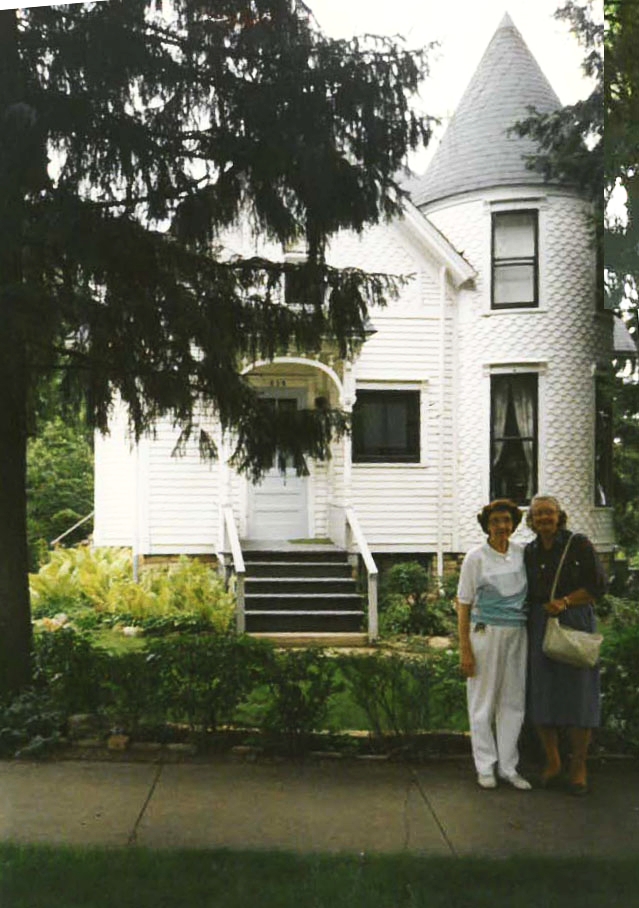539 RYERSON AVENUE
HISTORIC SIGNIFICANCE
The lot which 539 Ryerson Avenue was built upon was bought by Theodore Rovelstad in 1891. Theodore emigrated from Norway to Elgin in 1886, his five brothers proceeding him in the journey, with high hopes of making fine jewelry at the Rovelstad Jewelry Store or watches at the newly opened Watch Factory. From his earnings saved while working at the factory, he was able to buy two lots (535 and 539 Ryerson Avenue).
The following year, Theodore built the home that exists now at 539 along with a barn for $1,500. In the same year, he married a Ms. Anna Evans in the home’s parlor on February 22, 1883. Anna’s uncle, who was visiting from Norway, was a fine cabinet maker and built the staircase that is in the home.
The Rovelstads were hit with unfortunate circumstances due to the hard times at the watch factory. The company laid off nearly all of the workers, including Theodore forcing him to sell his new home and land to a friend as he was not able to make payments. The Rovelstads returned to Norway to stay with relations but returned back to Elgin the following year as the Watch Factory re-hired their employees. The Rovelstads bought back the property at the same price as they sold it.
The Rovelstads remained in the home for many years housing their family of eight as well as roomers as there was plenty of space in the home. Theodore worked at the Watch Factory for over 40 years before retiring. He passed away in 1950 leaving their family home to his wife, Anna, who passed away in 1960. The home was then given to their son, Trygve and his wife, Gloria. In the 1950s, Trygve built his studio on the adjacent, empty lot that is now 535 Ryerson. Trygve’s brother, Stanley, was also only a block away residing at 438 Ryerson. Stanley followed in their father’s footsteps and was a machine operator at the Watch Factory.
Trygve was a renowned sculptor and medalist who spent hours in the home’s tower, which became his first studio. This was where he drew, painted, modeled and studied anatomy, giving him the basis to become a prolific artist. The barn that now serves as a garage housed Trygve’s more advanced art activities.
One of Trygve’s first jobs was carving inscriptions on headstones at Elgin’s Bluff City Cemetery. He was quickly recognized for his natural talent and was given permission to study and work with an Internationally known, Italian plaster caster, Lorado Taft, who most famously worked on the Dutch Windmill on the Fabyan Estate located in Geneva, Illinois.
After Trygve graduated from Elgin High School in 1922, he was accepted in the Midway Studio which was one of the Midwest’s best known art centers, housing 30 young artists. He continued to work under Taft and often was a model for him. In Taft’s Alma Mater Monument, located at the University of Illinois – Urbana-Champaign campus, Trygve’s head and hands can be seen on the figure representing, "Labor.”
When Trygve returned back to Elgin in the early 1930s, the Mayor suggested Trygve create a statue to commemorate James T. Gifford, one of Elgin’s founding fathers. Trygve went above and beyond this initial idea and created a sculpture depicting a pioneer family, led by a scout, followed by a husband and wife with their infant child and young son. They are symbolically moving across the Illinois prairie to settle the new frontier which was once here in Elgin.
To raise funds for the sculpture, Elgin produced 20,000 Elgin Centennial Half Dollar coins, designed by Trygve. The coins were issued in 1936 right in the midst of the Depression and monies generated from the sale of the coins were not enough. War followed the Depression and Trygve was sent to work for the Army at the Office of the Quartermaster General as a Heraldic Artist. He designed several noteworthy pieces including: the Combat Infantry Badge; the General John J. Pershing Medal; the Organization Blue Unit Citation; the Legion of Merit Award; the Bronze Star ; and the 101st Airborne Division Medal (the “Screaming Eagle”). Trygve returned to Elgin in 1951 and continued his work on the Pioneer Memorial Monument, though, it was still a dream yet to be realized. Not until the late 1990s, when a combination of state, county and city funds, plus private donations, raised enough money to actually build the statue. This Pioneer Statue can been seen along the Fox River Bike Trail directly south of the Gail Borden Public Library. Unfortunately, Trygve Rovelstad did not live long enough to see the statue erected as he passed away on June 8, 1990.
ARCHITECTURAL SIGNIFICANCE
Designed in the Shingle style, 539 Ryerson has varied roof forms, different types of siding material, which are emphasized by the imaginative color scheme, and a prominent tower. The home is adorned with an array of detail including its overlaid trim around the fish scale, octagonal and butt shingles, the stick-and-ball fretwork over the front entry as well as the stained glass window found in the large central window on the front facade.
TIMELINE OF PREVIOUS OWNERS
Sources: 1994 Heritage Plaque Application; Gifford Park Association; Audio: TextAloud




